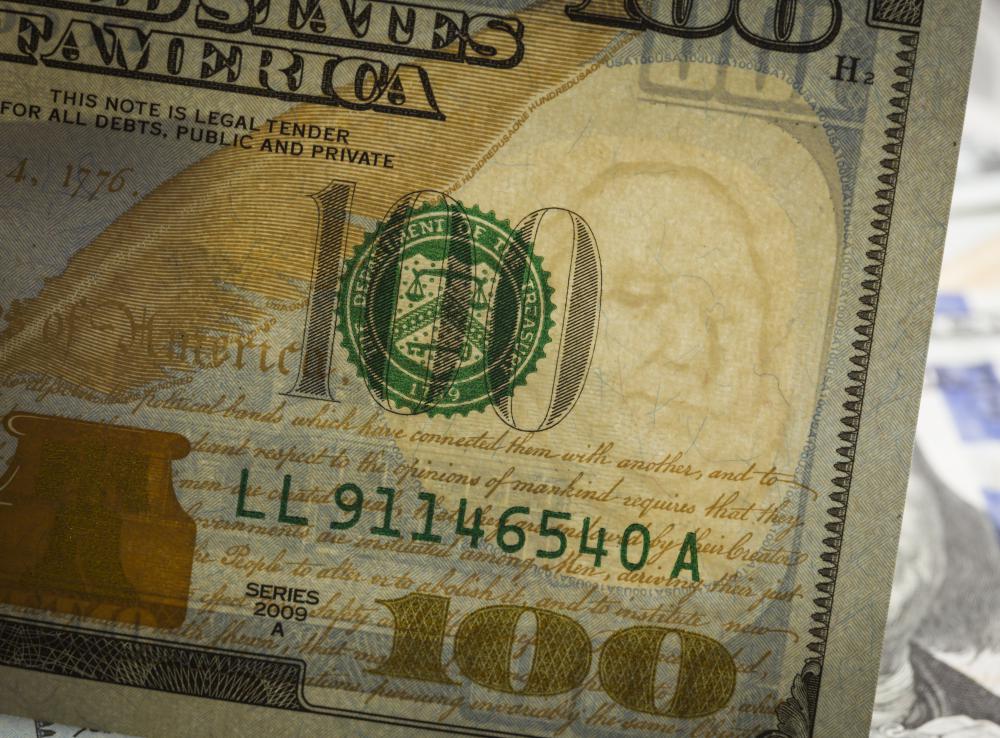At WiseGEEK, we're committed to delivering accurate, trustworthy information. Our expert-authored content is rigorously fact-checked and sourced from credible authorities. Discover how we uphold the highest standards in providing you with reliable knowledge.
What is Counterfeit Money?
Counterfeit money is currency created to imitate a government produced currency. It is generally designed to look like real money and to convince others that it is legitimate currency. Sometimes, counterfeit money is produced to purchase items or services, but at other times, it is created in an attempt to cause inflation.
While it is possible for both paper and coin money to be counterfeited, most counterfeit money today is paper. Before paper money, coins were counterfeited by mixing cheap metals with purer metals or bits of real coins. Casts or molds were then created to mimic the prints on a real coin.

Modern counterfeit money is generally made to look like bank notes. As technology has evolved, more realistic imitations of money have become possible through the use of digital graphics. Since most money is printed on material that is not available for public sale, the development of commercial printers has also allowed forgers to mimic the texture of real currency.

Modern governments use extensive anti-counterfeiting measures. Bills are produced with special raised images, holograms, and embedded elements to discourage counterfeiters. Paper money can are be redesigned to make it more difficult for forgers to keep up with counterfeit designs.
That material on which bank notes are printed is a key element in discouraging counterfeiting. "Paper" money is generally made from a specialized blend of paper and certain fabrics that can only be produced for the government. Some countries now use currency made out of a plastic polymer. These bills often include a clear window, which is very difficult to reproduce.

Counterfeiting money is a type of fraud and is considered a serious offense in most of the world. Information about counterfeiters is often shared between countries, as counterfeiters may attempt to use a faked currency in a foreign country. Sharing information allows officials to recognize the differences between real and counterfeit currency from other countries as well as their own.
Money may be counterfeited in order to purchase good or services, and counterfeit bills can be especially prevalent in unregulated or illegal businesses that are often cash based, such as the drug or weapons trades. Most industries are vigilant about counterfeit money, and employ anti-counterfeiting technologies.
In wartime, counterfeit money may be produced to "flood" an economy. Governments carefully regulate the amount of money printed as a way to maintain economic stability. When an economy suddenly has too much cash in the market, inflation occurs, and each unit of the currency is worth less. One side may try to weaken an enemy's economy by introducing vast quantities of counterfeited money into their country.
AS FEATURED ON:
AS FEATURED ON:













Discussion Comments
On a bad day, the business might decide to detain you while they contact local law enforcement. You'll have to explain how you got possession of that counterfeit bill in the first place. If you can convince the investigator that you had absolutely no idea the bill was counterfeit and you had no intention of committing fraud, you might get off with a stern warning to inspect any large bills in the future. When dealing with cash, especially denominations of $20 or higher, it pays to check it yourself or bring it to your bank for a second opinion.
If someone gives me a counterfeit bill that looks real, can I get in trouble for paying a cashier with it?
I remember a friend of mine made a bet he could pull a piece of plastic out of a one dollar bill. I gave him a new dollar bill and he tore one end just enough to pull out a plastic security strip. I had no idea the government added that strip to all new bills. It was just one more thing that counterfeiters could never duplicate when making fake money.
Only a few weeks later, I handed a clerk a twenty dollar bill and she ran a pen over it. I asked her what she was doing, and she said it was a test for counterfeit money. Apparently the ink in the pen would only react to real money. These days, it seems like there's a dozen different ways to tell a real bill from a counterfeit.
Post your comments